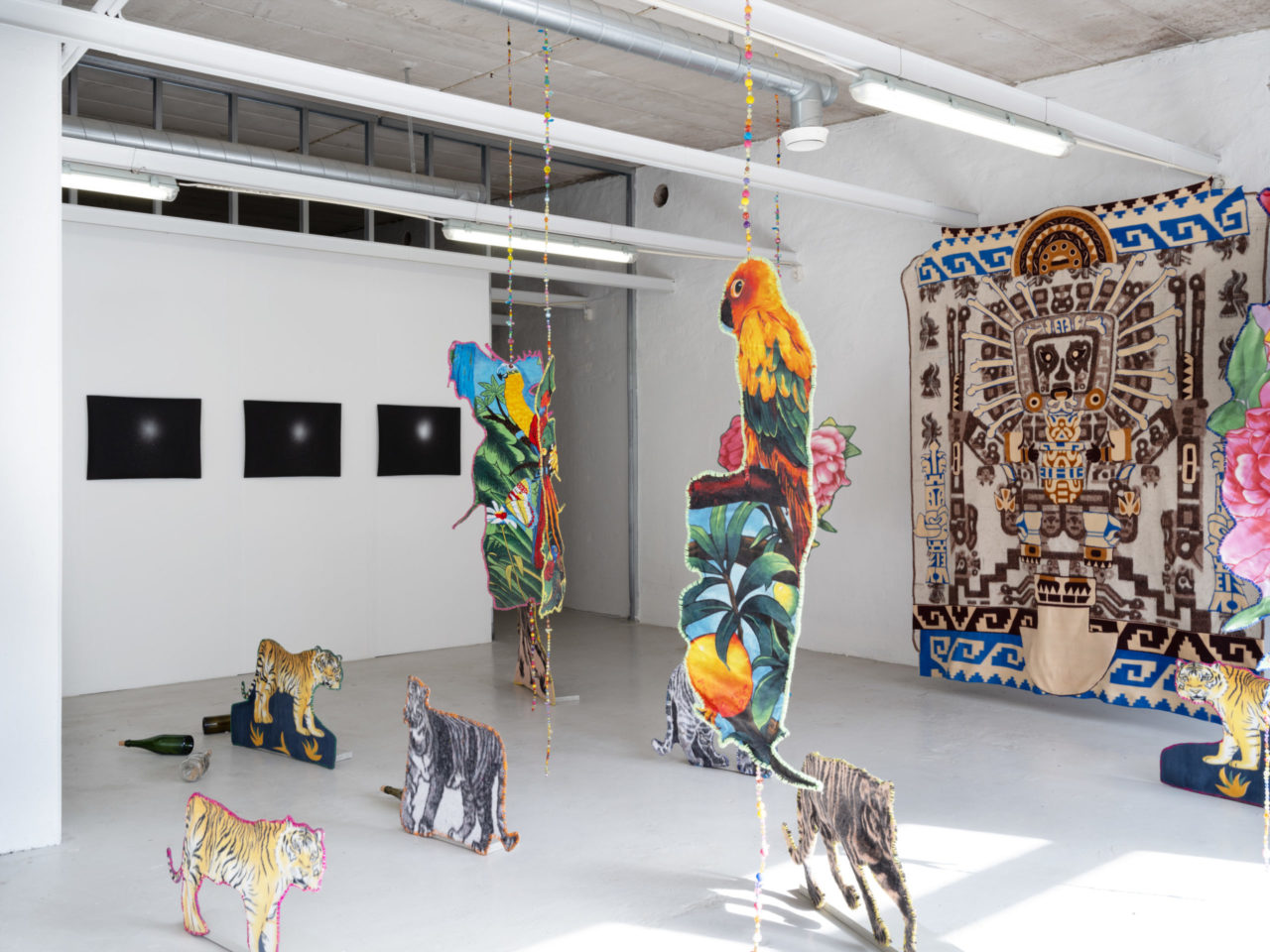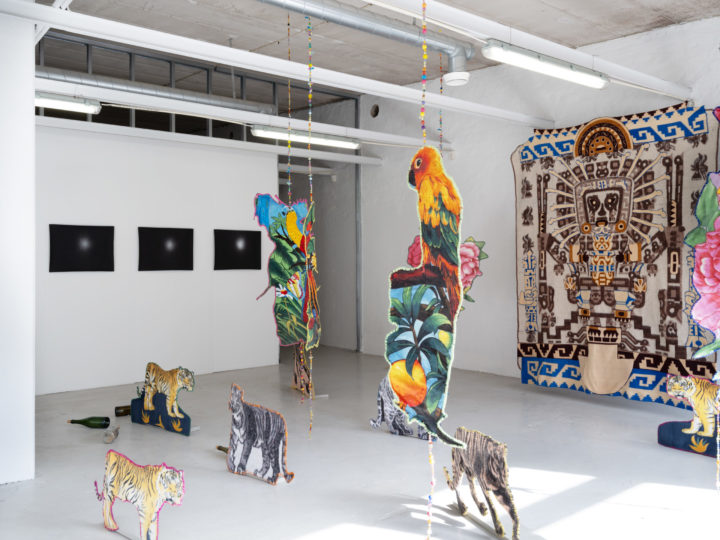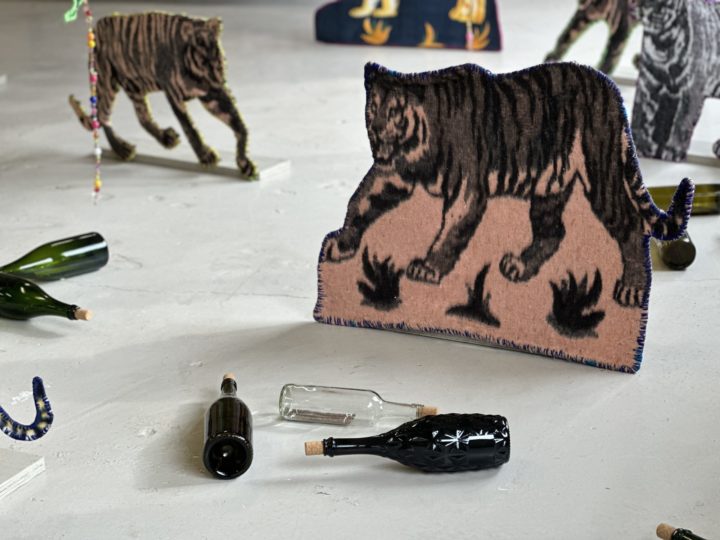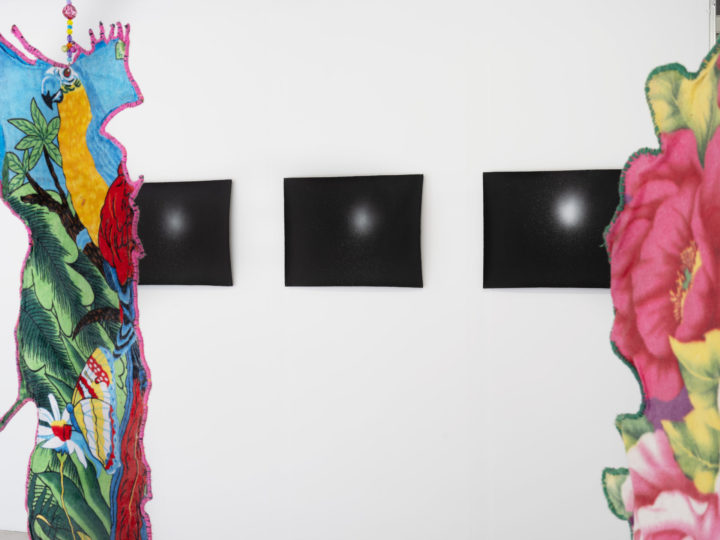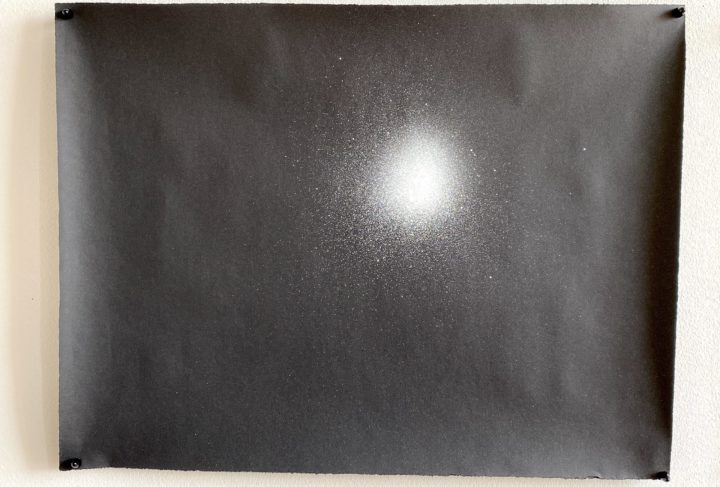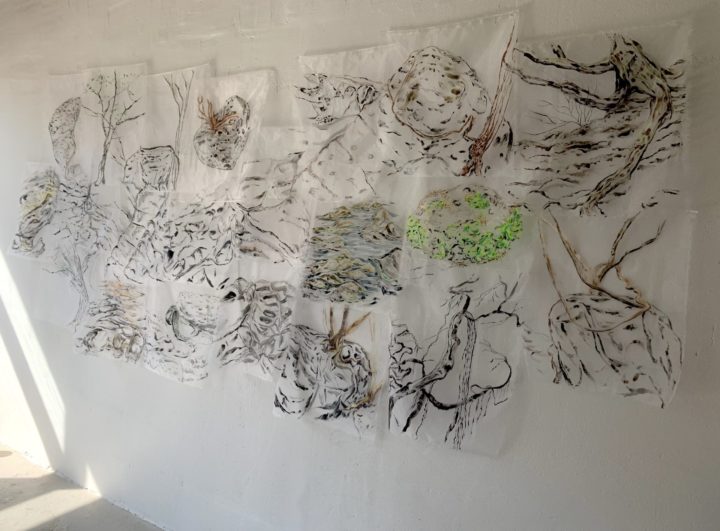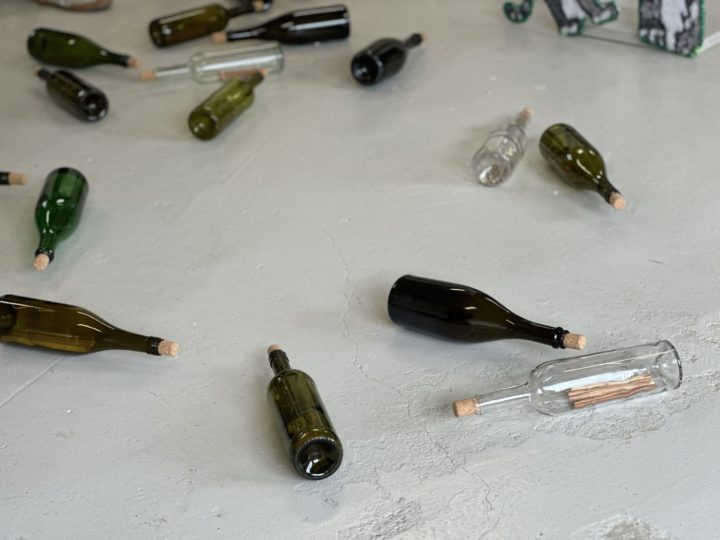‘La tierra y el mar’
La tierra y el mar
Eliana Otta & Carla Zaccagnini
01.06.2024 –21.07.2024
Curaduría de Fuxia 2 & Gris García
Aunque a ritmos distintos, la tierra y el mar (el mar y la tierra) se mueven, confundiéndose. A un mismo compás, a ritmos distintos.
La tierra y el mar pone en conversación las prácticas artísticas de Eliana Otta y Carla Zaccagnini. Ambas provenientes de diferentes rincones de esa vasta ficción de ficciones que llamamos Latinoamérica, un territorio marcado por medio milenio de violencia colonial. Las dos prestando atención a los contextos y lenguajes que habitan, que las habitan. Y, sin embargo, sería injusto quedarnos en este trazado de paralelismos. Sus trabajos muestran, por el contrario, un interés minucioso en las fisuras, las fallas de significado, los desbordes.
La exhibición acerca dos instalaciones que las artistas produjeron años atrás, antes de migrar a Europa. Toallas, botellas, joyas de plástico, ramas. Estas obras parten de narrativas de desplazamiento y desposesión, creando estructuras de esperanza por medio de objetos mundanos. La tierra y el mar presenta también dos series recientes de trabajos gráficos. En estas ilustraciones, más que denunciar una realidad política determinada, Carla y Eliana ensayan otras formas de sensibilidad. Escrituras geológicas, miradas cósmicas, diálogos transhistóricos. Una curiosidad por la plenitud y la finitud que atraviesan todas las cosas.
La práctica artística de Eliana irradia una fascinación por lo cotidiano: recorrer ferias y mercados, una mañana de domingo cualquiera, en busca de un hallazgo; recolectar cachivaches cuidadosamente; volver a casa y hacer con ellos pequeños altares. Tierra de nadie se compone de retazos de toallas y mantas, textiles con los que nos secamos el cuerpo tras salir del agua, o nos cubrimos en las noches frías. A ello habría que sumarle el murmullo urbano de Lima, ciudad natal de la artista, donde presentó este trabajo por primera vez en 2011. Las frazadas del tigre, tan habituales en las casas del Perú, tienen una especial carga afectiva para los migrantes, que hacen uso de ellas en sus viajes. Así, esos tigres estampados se convierten en salvaguardas de la vida en tránsito. Entretejiendo materiales diversos y trenzando joyas de fantasía, Eliana crea una instalación que se despliega como un paisaje orgánico, un cobijo ante el desarraigo impuesto por el capitalismo.
las zarpas del tigre
los barcos que zarpan
Ramita a ramita, se trama una fuga. La primera iteración de The sea you see will never be the sea I’ve seen tomó forma en 2017. En aquel entonces Carla fue armando embarcaciones hechas de ramas, reminiscentes a las pateras sobre las que tantos se arrojan al mar para entrar a Europa. Balsas que llegan ahora a otras orillas. La instalación juega con la tradición artesanal de las carabelas embotelladas, heredada del siglo XVIII. Si aquellos recipientes de cristal traían consigo los ecos triunfantes de los conquistadores, estas botellas contienen imaginarios anticoloniales. Al igual que en muchos de sus trabajos, la artista atiende aquí a los relatos menores, esas historias que, aún sumidas en el olvido, salen a flote mientras los barcos se hunden. Ya desde su título, la obra inserta una sospecha sobre cualquier mirada inocente a la geografía. Vemos y no vemos el mismo mar. Pisamos y no pisamos la misma tierra.
crash
oleadas que forman montañas, delinean continentes y fronteras,
y a su vez las borran
crash crash
mensajes que llegan a nuestras costas, pero no queremos ver
desde dentro de la botella
sin saberlo
Quizá, para percibirlo todo, haya que mirar de más cerca. En Amistades (2024), una serie de dibujos sobre organza, Eliana se inspira en rocas halladas en las costas de México, Perú, Grecia y Corea. Independiente de cualquier anclaje geográfico, la artista se aproxima a la roca como un ecosistema en sí mismo, materia atravesada por un flujo oculto de interrelaciones vitales. El uso de la organza, derivado de la seda que destaca por su liviandad, parte de un deseo por ensalzar la suavidad que subyace a las piedras, así como el movimiento que estas acogen. Al superponer las ilustraciones, se desdibujan sus márgenes, dando pie a intimidades y transparencias. O, dicho de otro modo, a amistades. Con este trabajo, Eliana pone en marcha un ejercicio de acercamiento a la realidad más allá de las ataduras inherentes a la subjetividad antropocéntrica. Un acto de escucha a las afinidades afectivas que sostienen la vida.
las rocas no están abocadas a la muerte, aunque saben lo que es nacer
levantar una piedra es sujetar un mundo
Vidas condensadas en una exhalación, mensajes destinados a miradas futuras. Con Anywhere Is My Land (2024) Carla propone una suerte de apertura de marco, tanto en el plano espacial como en el temporal. Algunos de sus trabajos más recientes están inspirados en las inscripciones paleolíticas albergadas en la Cueva El Castillo, al norte de España. Esta serie de pinturas sopladas nos remite a esas marcas que dejamos en la tierra, atestiguando nuestra existencia y dando prueba de su finitud. El trabajo alude además a la pintura homónima del artista brasileño Antonio Dias, fechada en 1968. Ya en Europa, con su país sumido en una dictadura militar que se extendería por casi dos décadas más, Dias se propone desarrollar un lenguaje plástico que fuera capaz de captar la experiencia del exilio. “Quería una no imagen que pudiera serlo todo. Empecé a hacer mapas como si fueran un camino en el desierto”. La no imagen de una tierra que no es de nadie y, a su vez, es de cualquiera.
Pero la piel de la tierra no tiene costuras.
Al mar no se le pueden poner vallas,
the sea no se detiene en las fronteras.
—Gloria Anzaldúa
La tierra y el mar
Eliana Otta & Carla Zaccagnini
01.06.2024 –21.07.2024
Curated by Fuxia 2 & Gris García
While at different rhythms, the land and the sea (the sea and the land) move, intertwining. At different rhythms, to the same beat.
La tierra y el mar sparks a conversation between the artistic practices of Eliana Otta and Carla Zaccagnini. Both coming from different corners of the same vast fiction of fictions that we call Latin America, a territory marked by half a millennium of colonial violence. Two artists paying attention to the contexts and languages they inhabit, that inhabit them. And yet, it would be unfair to stop at these reductive parallels. Their work shows, above all, a relentless interest in the frictional, the failures of meaning, that which overflows.
The exhibition brings together two installations that the artists produced years ago, before migrating to Europe. Towels, branches, plastic jewelry, bottles. These works depart from narratives of displacement and dispossession, creating structures of hope through mundane objects. La tierra y el mar also presents two recent series of graphic works. In these illustrations, rather than addressing a particular political reality, Carla and Eliana rehearse other forms of sensibility. Geological writings, cosmical contemplations, transhistorical dialogues. A curiosity for the plenitude and the finitude of all things.
Eliana’s artistic practice radiates a fascination with the everyday: strolling through street fairs and local markets on a Sunday morning, in search of a new find; carefully collecting trinkets; returning home and building small altars out of them. No one’s land is made of towel scraps and blankets, textiles with which we dry our bodies when we get out of the water, or we cover ourselves on cold nights. While imperceptible, the installation also carries the murmur of Lima, Eliana’s hometown and the city where she presented this work for the first time in 2011. The tiger blankets, so common in Peruvian homes, have a special affective charge for migrants, who make use of them on their journeys. Thus, these printed tigers become guardians of a life in transit. Interweaving colorful fabrics and beading plastic pearls, Eliana creates an installation that unfolds like an organic landscape, a shelter from the uprooting imposed by capitalism.
the claws of the tiger
the ships that set sail
Twig by twig, escapes are plotted. The first iteration of The sea you see will never be the sea I’ve seen took shape in 2017. At that time Carla was assembling rafts made of branches, reminiscent of the precarious boats used by many to cross the sea and enter Europe. Rafts that have now reached a new shore. The installation plays with the artisanal tradition of the bottled ship, inherited from the 18th century. If those glass containers carried the triumphant echoes of the conquistadors, these bottles contain anti-colonial imaginaries. As in many of her works, here the artist focuses on minor narratives. Those stories that, despite being forced into oblivion, come to the surface while the ships are sinking. Already in its title, the work puts any innocent look at geography under suspicion. We see and do not see the same sea. We tread and do not tread the same land.
crash
waves forming mountains, outlining continents and borders,
and in turn erasing them
crash crash
messages that reach our shores, but we don’t want to see
from inside the bottle
without being aware
To grasp it all, one must perhaps look closer. In Friendships (2024), a series of drawings on organza, Eliana takes inspiration from rocks found on the coasts of Mexico, Peru, Greece and Korea. Independently of any geographical anchoring, the artist approaches the rock as an ecosystem in itself, matter crossed by a hidden flow of living interactions. The use of organza, a type of lightweight, sheer silk, stems from a desire to uncover the stone’s softness, as well as all the movement that it houses. By superimposing the illustrations, their margins are blurred, giving rise to intimacies and transparencies. Or, in other words, friendships. With this work, Eliana attempts to approach reality beyond the constraints inherent to anthropocentric subjectivity. An act of listening to the affective affinities that sustain life.
rocks are not meant to die, yet they know what it is to be thrown into life
to lift a stone is to hold a world
Life condensed in an exhalation, messages intended for the future. With Anywhere Is My Land (2024) Carla proposes to widen the scope, both spatially and temporally. Some of her most recent works are inspired by the Palaeolithic inscriptions housed in Cueva El Castillo in northern Spain. This series of blown paintings evokes those marks we leave behind, both testifying to our existence and giving proof of its finitude. The work also alludes to the painting of the same name by Brazilian artist Antonio Dias, from 1968. Already in Europe, with his country under a military dictatorship that would last for almost two more decades, Dias sought to develop an aesthetic language capable of capturing the experience of exile. ‘I wanted a non-image that could be everything. I started making maps as if they were a path in a desert’. The non-image of a land that belongs to no one, belongs to anyone.
But the skin of the earth is seamless.
The sea cannot be fenced,
el mar does not stop at borders
—Gloria Anzaldúa
